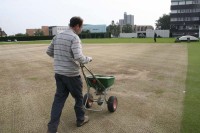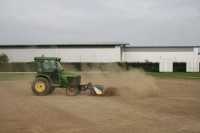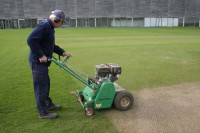End of season renovation
October! Season's end, the final ball has been bowled, the last wicket taken and the winning run scored. Now it's the time to mothball the flannels, put away the bat and ball and put your feet up. All well and good if you are a player; but who has the task of putting the square to right at the seasons end? That jolly good chap the groundsman, a dedicated and devoted campaigner. Let's hope it is in as good a condition next season as it was this year?
 With the sound of leather on willow as the ball hurtles towards the boundary board, the benefits of some T.L.C at the end of each season contribute to a lot of pleasure and enjoyment from players and spectators alike. But, to play on a decent wicket with a little bit in it for both batsman and bowler, is the whole essence of the Spirit of Cricket. Not every pitch though can be like Lord's, Old Trafford or Trent Bridge.
With the sound of leather on willow as the ball hurtles towards the boundary board, the benefits of some T.L.C at the end of each season contribute to a lot of pleasure and enjoyment from players and spectators alike. But, to play on a decent wicket with a little bit in it for both batsman and bowler, is the whole essence of the Spirit of Cricket. Not every pitch though can be like Lord's, Old Trafford or Trent Bridge.
Why the need then for end of season renovation?
Nearly all cricket squares look tired and forlorn by seasons end and are in need of revitalising, so the need to be rejuvenated is the same as taking 5 wickets or scoring a century!
Too many club pitches do not perform very well in terms of pace and bounce, as wear and tear is magnified during use. Generally, it is usually a combination of two factors when combined that is the cause of most problems. Firstly, failure to remove sufficient build up of organic matter, or thatch during pitch preparation or renovation. Secondly, applying insufficient top dressing to increase the bulk density of the soil profile.
Most club grounds men though have their own methods of work when renovating their squares. In most cases the level of work will be dictated by what budgets and resources they have available at the time and what they are trying to achieve. The object of renovation is to revitalize the top growing rootzone and restore surface levels.
Lineer aeration and mechanical scarification plays an important part to remove unwanted vegetation, but also to produce a key for the new loam material and grass seed to sit in. Initially, any renovation or scarification work on the square should be an ongoing affair. The level of scarification required will be dependent on how much of a thatch layer you have generated throughout the season. This year has seen periods of heavy rain followed by high temperatures and grass growth has been prolific; thatch content therefore is likely to be on the high side. The best way to identify how much you have is by taking a core sample.
 At Massey Ferguson C.C we have 12 strips on the square, 10 are used for seniors and 2 for junior representative matches. We also have an artificial on a separate site for academy cricket. The club play their cricket in the Warwickshire League with 2 Saturday sides, a midweek side that plays Tuesday, Wednesday and Thursday. On Sundays it is hired out to an Asian team to play league cricket.
At Massey Ferguson C.C we have 12 strips on the square, 10 are used for seniors and 2 for junior representative matches. We also have an artificial on a separate site for academy cricket. The club play their cricket in the Warwickshire League with 2 Saturday sides, a midweek side that plays Tuesday, Wednesday and Thursday. On Sundays it is hired out to an Asian team to play league cricket.
The first task for the groundsman's end of season renovation programme starts with the whole square being mowed out in 2 directions, from corner to corner. The first cut being at 5mm, the height of cut is then lowered to 3- 4mm. The square is then irrigated for a couple of days to allow moisture to penetrate into the top 100mm of the surface. After taking a core sample from different parts of the square to measure thatch content, it is then a case of going through a vigorous programme of lineer aeration, scarifying in at least three to four directions increasing the depth after two passes; 1st set @ 4mm the 2nd @ 8mm, finishing in the line of play. All risings are removed after each pass.
 The square is then given a sorrel roll in four directions to create as many holes as possible for the seed to drop into. It is then over seeded using 2 bags of Barenbrug Bar Extreme 100% perennial rye grass with three cultivars. Sowing rates can range between 35-50 grammes per square metre depending wear and tear. In essence the aim is to establish new grasses into the square. A light top dressing as applied and drag matted into cover the seed then fertilised with an autumn & winter feed of Sherriff Amenity 6.5.10. It is then irrigated to assist in the germination of new seed.
The square is then given a sorrel roll in four directions to create as many holes as possible for the seed to drop into. It is then over seeded using 2 bags of Barenbrug Bar Extreme 100% perennial rye grass with three cultivars. Sowing rates can range between 35-50 grammes per square metre depending wear and tear. In essence the aim is to establish new grasses into the square. A light top dressing as applied and drag matted into cover the seed then fertilised with an autumn & winter feed of Sherriff Amenity 6.5.10. It is then irrigated to assist in the germination of new seed.
A programme of decompaction of the soils following germination, is essential to re-introduce some porosity into the profile as this enables the top dressing to filter into the holes. When the seed has germinated well enough topdressing is then applied to restore levels, @ 300kg per pitch, and to integrate new material into the soil profile this helps to build up the bulk density and clay content in the square.
 Aeration is also a key operation to help improve the condition of the soil following a season's play. Soil compaction is often the main contributing factor to poor grass growth; the lack of air in the soil profile inhibits many beneficial activities such as soil, water movement and retaining Microbial Organisms.
Aeration is also a key operation to help improve the condition of the soil following a season's play. Soil compaction is often the main contributing factor to poor grass growth; the lack of air in the soil profile inhibits many beneficial activities such as soil, water movement and retaining Microbial Organisms.
Solid tinning, hollow coring and linear aerating are a number of methods now being used to aerate soil profiles. These operations tend to be carried out on a frequency basis depending on the type and size of the tines being used.
The frequency of aeration activities will often depend on the resources - money, machinery, and time - available. In the main, end of season renovation does not finish as soon as the top dressing goes down, I would be looking to aerate throughout the winter period on a monthly basis, weather and soil conditions permitting.
SUMMARY OF PROGRAMME OF WORK
1. Mow or shave the square down to 4-6mm 2 directions corner to corner removing all cuttings.
2. Power Scarify the square in three to four directions, depending on how much thatch has been accumulated throughout the season. The depth will depend on the core sample reading or feed back from a Cricket Board Advisor.
3. Irrigate the square copiously to get moisture into the top 100mm of the soil profile.
4. Aerate with sorrel roller or verti -seeder, in a union flag direction, to create pot holes for the seed.
5. Over seed with 35g /m.sq. Of Barenbrug bar Extreme.
6. Light top dressing and fertilise with Sherriff Amenity Autumn/ winter fertiliser, 6.5.10
7. Irrigate square to wash in fertiliser & germinate seed.
8. Aerate and de compact square with a Groundsman vertical power deep solid tinner in 2 directions.
9. Top dress square with K Loam @ 300kg per pitch, brush /drag mat material into holes.
10. Protect Square with barrier fencing and rope off. Put up signs; Keep Off!!
EQUIPMENT USED
1. Massey Ferguson 1540 compact tractor.
2. Ransomes 51 super cert's pedestrian mower.
3. Lawnflite power scarifier.
4. Pattison sorrel roller.
5. Pedestrian cyclone fertiliser spreader.
6. Groundman powered deep aerator solid tinner.
7. Vicon Tractor mounted top dresser.
8. Drag mat - brush & hand tools.
9. Travelling water sprinkler & hose pipe.
All works are carried out in house. The programme takes about three - four weeks to complete, weather permitting, as football is played on the ground either side of the square. The aims are to achieve a square with a thatch free profile with a good healthy sward and root development.
What are the problems associated with a poorly maintained square and why should end of season renovation be so important?
 It is a fact that many clubs after the last match of the season pack their bags and don't meet again till the following year. With the square left to its own devices, they are aghast to see its state the following spring. Carrying out no renovation on the square will inevitably result in poor performances, presentation and sustainability.
It is a fact that many clubs after the last match of the season pack their bags and don't meet again till the following year. With the square left to its own devices, they are aghast to see its state the following spring. Carrying out no renovation on the square will inevitably result in poor performances, presentation and sustainability.
With this in mind, much of the anxiety experienced through the winter and spring by some grounds men could be avoided by correct maintenance during the autumn season, when various important operations, such as Aeration, Scarification, Weed & Pest control, Seeding, Mowing and Top dressing should have been carried out on the square. It is for this reason that any renovation carried out on the square should be completed before the onset of winter. Failure to do so before the start of the next playing season will result in unpleasant and worrying conditions. These conditions are exaggerated by continually neglecting the square year after year.
One of the most common problems associated with poorly maintained squares is the lack of pace and bounce. This is when the ball fails to bounce because the thatch layers act as a cushion absorbing all the energy put into the delivery. Finding the answer though is not so straight forward, as there may be a number of contributing factors. Failure to power scarify the whole square to remove sufficient thatch during the autumn and spring for one, or, applying an incorrect application of top dressing without any scarification when the grasses are to long is another major fault that can give rise to the increase in layers of vegetation.
Other examples of a poorly managed square could be seen as bare patches due to lack of grass coverage; badly worn ends, resulting in pot holes & undulations and; Pests & Disease. The most common of which is, FUSARIUM, Microdochium nivale. A pathogenic fungus is most active under neutral or alkaline conditions at the turf surface; EARTHWORMS, Lumbricus terrestis (casting worms) and LEATHERJACKETS, the lava stage of various species of Tipula.
DISEASE
 In turf, pathogenic fungi are often present in the build up of thatch and soil, but the disease will only occur in suitable environmental conditions. Fusarium patch disease is probably the most damaging and disfiguring disease for fine turf cricket squares during the winter & spring months. It first appears as small round orange / brown water soaked spots which , under favourable conditions, increases in size rapidly coalesce together to form large irregular scars. Fusarium is favoured by the presence of a deep thatch layer, where the soil lacks aeration and is poorly drained, as thatch is often moisture retentive its constituent dead plant material is a natural substrate for the disease. Any cricket square containing a large percentage of Annual meadow- grass (Poa annua) would suffer severe damage. The reason for an attack derives from neglecting aeration, brushing, or switching any dew off the surface to keep it dry or not applying a systemic fungicide to combat it.
In turf, pathogenic fungi are often present in the build up of thatch and soil, but the disease will only occur in suitable environmental conditions. Fusarium patch disease is probably the most damaging and disfiguring disease for fine turf cricket squares during the winter & spring months. It first appears as small round orange / brown water soaked spots which , under favourable conditions, increases in size rapidly coalesce together to form large irregular scars. Fusarium is favoured by the presence of a deep thatch layer, where the soil lacks aeration and is poorly drained, as thatch is often moisture retentive its constituent dead plant material is a natural substrate for the disease. Any cricket square containing a large percentage of Annual meadow- grass (Poa annua) would suffer severe damage. The reason for an attack derives from neglecting aeration, brushing, or switching any dew off the surface to keep it dry or not applying a systemic fungicide to combat it.
AERATION
Why Aerate? As a cricket square is made up of heavy clay soils so aeration is vitally important. Drainage is a vital aspect of good turf management enhancing free movement of water through the soil profile. This helps keep nutrients in circulation and increase the effectiveness of irrigation and root development in the summer. If thorough aeration is not been carried out to de- compact the square, i.e. by deep tinning hollow coring or sorrel rolling this will unduly impede the health and vigour of the turf denying free passage of Water, Air and Nutrients to encourage root development, which is important to binding the pitch surface together preventing cracking, crumbling and allows top dressing to migrate into the tine holes. Aeration should be seen as a positive measure, not merely as a disruption to the playing surface.
SCARIFICATION
 For the control of lateral grass growth, scarification is as important as the mowing for the sake of turf vigour, playing quality and presentation of a cricket square. The purpose of scarification is to remove any unwanted accumulation of thatch or fibre which can sit just below the surface and by removing stoloniforous stems that creep along the playing surface. If scarification is not carried out the square will soon develop into bumpy, spongy and most likely moisture retentive. This environment would encourage the likes of moss, worm activity and algae, making the pitch often erratic and dangerous. Prolonged wet spells and mild conditions through autumn and spring are often linked with an upsurge in worm activity caused by adverse wet conditions. Heavy casting themselves can create extremely muddy and unsightly conditions which effects appearance, damage surface levels, drainage, sward density and increase weed population. Prevention is better than a cure.
For the control of lateral grass growth, scarification is as important as the mowing for the sake of turf vigour, playing quality and presentation of a cricket square. The purpose of scarification is to remove any unwanted accumulation of thatch or fibre which can sit just below the surface and by removing stoloniforous stems that creep along the playing surface. If scarification is not carried out the square will soon develop into bumpy, spongy and most likely moisture retentive. This environment would encourage the likes of moss, worm activity and algae, making the pitch often erratic and dangerous. Prolonged wet spells and mild conditions through autumn and spring are often linked with an upsurge in worm activity caused by adverse wet conditions. Heavy casting themselves can create extremely muddy and unsightly conditions which effects appearance, damage surface levels, drainage, sward density and increase weed population. Prevention is better than a cure.
MOWING
The use of cylinder mowers are the most common machines used on cricket squares, but if poorly maintained and the blades are not kept sharp this will have an effect on your grasses. Mowing practices need to be monitored. Gradual adjustments reducing the height of cut must be made accordingly to prolong the life of the plant. Blunt blades will tear the plant rather than cut with a clean action, causing the leaf to be ripped so encouraging disease to enter the plant. As mowing the square regularly encourages sward density, mowing out the pitches too short to early will result in stressing the plant, reduces the photosynthesis, which helps the plant recover, and cause damage to the root system. Mowing is a precise art, if not carried out properly it can have catastrophic consequences on the square.
OVERSEEDING
 The importance of over seeding cannot be under estimated. Grass seed requires a base in which it needs to attach itself. If linear aeration, sorrel rolling, solid tinning or top dressing has not been carried out, then the seed would not be able to have contact with the soil. The seed would fail to germinate and could be washed away or eaten by the birds. In most circumstances a mixture of dwarf perennial rye grass seed (Lolium perenne) with 3 different varieties or cultivars is favoured. Its superior wear tolerance, rapid establishment and persistence makes it highly suitable for most cricket squares. Failure to over seed the square effectively, to create a dense healthy sward, would encourage undesirable weeds to colonise in the bare patches. Grasses such as Annual meadow grass,
The importance of over seeding cannot be under estimated. Grass seed requires a base in which it needs to attach itself. If linear aeration, sorrel rolling, solid tinning or top dressing has not been carried out, then the seed would not be able to have contact with the soil. The seed would fail to germinate and could be washed away or eaten by the birds. In most circumstances a mixture of dwarf perennial rye grass seed (Lolium perenne) with 3 different varieties or cultivars is favoured. Its superior wear tolerance, rapid establishment and persistence makes it highly suitable for most cricket squares. Failure to over seed the square effectively, to create a dense healthy sward, would encourage undesirable weeds to colonise in the bare patches. Grasses such as Annual meadow grass,
Poa annua and Smooth Stalked Meadow grass (Poa pratensis), may also be present. Using a cheap and cheerful mixture to could result in a thin weak grass composition.
TOPDRESSING
Without a doubt the key point to any end of season renovation maintenance treatment for a cricket square must be the top dressing. Numerous benefits derive from top dressing a cricket square, but maximum gain is only possible if applications are made regularly as part of your turf maintenance programme. The benefits of top dressing a table is an effective method of building up a true surface and improving the efficiency of mowing. Newly seeded area's can also be protected from the elements and bird damage. Top dressings act as small plant food value reducing the amount of artificial feeding. If the square is not top dressed properly with a suitable heavy loam then the surface will fail to bind, become porous, uneven and dangerous By introducing a quality approved material suitable to your square, i.e. Ongar, Banbury, Surrey, K loam or even Mendip, will help key together existing soils and thus provide an ideal playing surface.
If you are interested in a Cricket Pitch Renovation Training Course, please contact Pitchare Training
